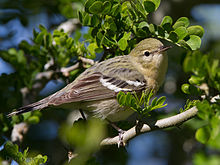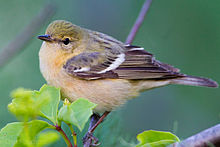- Bay-breasted Warbler
-
Bay-breasted Warbler 
Conservation status Scientific classification Kingdom: Animalia Phylum: Chordata Class: Aves Order: Passeriformes Family: Parulidae Genus: Dendroica Species: D. castanea Binomial name Dendroica castanea
(Wilson, 1810)The Bay-breasted Warbler, Dendroica castanea , is a New World warbler. They breed in northern North America, specifically in Canada, into the Great Lakes region, and into northern New England.
These birds are migratory, wintering in northwest South America and southern Central America. They are very rare vagrants to western Europe.
This species is closely related to Blackpoll Warbler, but this species has a more southerly breeding range and a more northerly wintering area.
The summer male Bay-breasted Warblers are unmistakable. They have grey backs, black faces, and chestnut crowns, flanks and throats. They also boast of bright yellow neck patches, and their underparts are white. They have two white wing bars, as well.
Breeding females essentially resemble washed out versions of the male. The females are greyish above and white below, with much weaker head patterns. The females also only have chestnut markings on small flank patches, although tiny tints in their grey crowns have been observed.
Non-breeding birds have greenish heads, greenish upperparts and yellowish breasts. The yellow extends to the belly of young birds. The two white wing bars are always present in every stage of life. These birds differ from non-breedering Blackpoll Warblers in the absence of breast streaks.
Their breeding habitats are coniferous woodlands. Bay-breasted Warblers nest in conifer, laying 3-5 eggs in a cup-shaped nest. More eggs are laid in Spruce Budworm years.
These birds feed on insects, and the numbers of these birds vary with the abundance of the Spruce Budworm. These birds will also feed on berries and nectar in wintertime.
Their songs are repetitive high-pitched si si si's.
Contents
References
- BirdLife International (2004). Dendroica castanea. 2006. IUCN Red List of Threatened Species. IUCN 2006. www.iucnredlist.org. Retrieved on 5 May 2006. Database entry includes justification for why this species is of least concern
New World Warblers by Curson, Quinn and Beadle, ISBN 0-7136-3932-6
Further reading
Books
- Williams, J. M. 1996. Bay-breasted Warbler (Dendroica castanea). In The Birds of North America, No. 206 (A. Poole and F. Gill, eds.). The Academy of Natural Sciences, Philadelphia, and The American Ornithologists’ Union, Washington, D.C.
Reports
- Cooper JM, Enns KA & Shepard MG. (1997). Status of the bay-breasted warbler in British Columbia. Canadian Research Index. p. n/a.
- Norton MR. (2001). Status of the Bay-breasted warbler, Dendroica castanea, in Alberta. Canadian Research Index. p. n/a.
Thesis
- Clarke M. M.Sc. (2005). Avian abundance and habitat relationships in a managed forest landscape in eastern Nova Scotia. Dalhousie University (Canada), Canada.
- Greenberg RS. Ph.D. (1981). THE WINTER EXPLOITATION SYSTEMS OF BAY-BREASTED AND CHESTNUT-SIDED WARBLERS IN PANAMA. University of California, Berkeley, United States, California.
- McMartin DW. M.Sc. (1996). Impact of insecticide applications on the foraging behaviour and diet of three boreal forest warbler species. University of Toronto (Canada), Canada.
Articles
- Apfelbaum S & Haney A. (1981). Bird Populations before and after Wild Fire in a Great Lakes USA Pine Forest. Condor. vol 83, no 4. pp. 347–354.
- Caroline G, Marcel D, Jean-Pierre LS & Jean H. (2004). Are temperate mixedwood forests perceived by birds as a distinct forest type?. Canadian Journal of Forest Research. vol 34, no 9. p. 1895.
- Cumming EE & Diamond AW. (2002). Songbird community composition versus forest rotation age in Saskatchewan boreal mixedwood forest. Canadian Field Naturalist. vol 116, no 1. pp. 69–75.
- Drolet B, Desrochers A & Fortin M-J. (1999). Effects of landscape structure on nesting songbird distribution in a harvested boreal forest. Condor. vol 101, no 3. pp. 699–704.
- Ellison K, Sykes PW, Jr. & Bocetti CI. (2002). Re-evaluating the Bay-breasted Warbler breeding range: Nine years of presence in Lower Michigan. Wilson Bulletin. vol 114, no 3. pp. 415–416.
- Ferguson D. (1997). Bay-breasted warbler in Cornwall: New to Britain and Ireland. British Birds. vol 90, no 10. pp. 444–448.
- Graves GR. (1996). Hybrid wood warblers, Dendroica striata X Dendroica castanea (Aves: Fringillidae: Tribe Parulini) and the diagnostic predictability of avian hybrid phenotypes. Proceedings of the Biological Society of Washington. vol 109, no 2. pp. 373–390.
- Greenberg R. (1983). Role of Neophobia in Determining the Degree of Foraging Specialization in Some Migrant Warblers. American Naturalist. vol 122, no 4. pp. 444–453.
- Greenberg R. (1984). Differences in Feeding Neophobia in the Tropical Migrant Wood Warblers Dendroica-Castanea and Dendroica-Pensylvanica. Journal of Comparative Psychology. vol 98, no 2. pp. 131–136.
- Greenberg R. (1985). A Comparison of Foliage Discrimination Learning in a Specialist and a Generalist Species of Migrant Wood Warbler Aves Parulidae. Canadian Journal of Zoology. vol 63, no 4. pp. 773–776.
- Hobson KA & Bayne E. (2000). Effects of forest fragmentation by agriculture on avian communities in the southern boreal mixedwoods of western Canada. Wilson Bulletin. vol 112, no 3. pp. 373–387.
- Hobson KA & Bayne E. (2000). The effects of stand age on avian communities in aspen-dominated forests of central Saskatchewan, Canada. Forest Ecology & Management. vol 136, no 1-3. pp. 121–134.
- McMartin B, Bellocq I & Smith SM. (2002). Patterns of consumption and diet differentiation for three breeding warbler species during a spruce budworm outbreak. Auk. vol 119, no 1. pp. 216–220.
- Meiklejohn BA & Hughes JW. (1999). Bird communities in riparian buffer strips of industrial forests. American Midland Naturalist. vol 141, no 1. pp. 172–184.
- Morse DH. (1978). Populations of Bay-Breasted and Cape-May Warblers During an Outbreak of the Spruce Budworm. Wilson Bulletin. vol 90, no 3. pp. 404–413.
- Potvin F & Bertrand N. (2004). Leaving forest strips in large clearcut landscapes of boreal forest: A management scenario suitable for wildlife?. For Chron. vol 80, no 1. pp. 44–53.
- Rodewald PG & Matthews SN. (2005). Landbird use of riparian and upland forest stopover habitats in an urban landscape. Condor. vol 107, no 2. pp. 259–268.
- Sealy SG. (1979). Extralimital Nesting of Bay-Breasted Warblers Dendroica-Castanea Response to Forest Tent Caterpillars. Auk. vol 96, no 3. pp. 600–603.
- Stewart PA. (1986). Fall Migration of Twelve Species of Wood Warblers through Coastal Virginia USA. North American Bird Bander. vol 11, no 3. pp. 83–88.
- Venier LA, McKenney DW, Wang Y & McKee J. (1999). Models of large-scale breeding-bird distribution as a function of macro-climate in Ontario, Canada. Journal of Biogeography. vol 26, no 2. pp. 315–328.
-->
External links
- Bay-breasted Warbler videos on the Internet Bird Collection
- Bay-breasted Warbler Species Account - Cornell Lab of Ornithology
- Bay-breasted Warbler - Dendroica castanea - USGS Patuxent Bird Identification InfoCenter
- Bay-breasted Warbler Information - South Dakota Birds and Birding
- Bay-breasted photo gallery VIREO Photo-High Res--(Close-up)
Categories:- IUCN Red List least concern species
Wikimedia Foundation. 2010.




